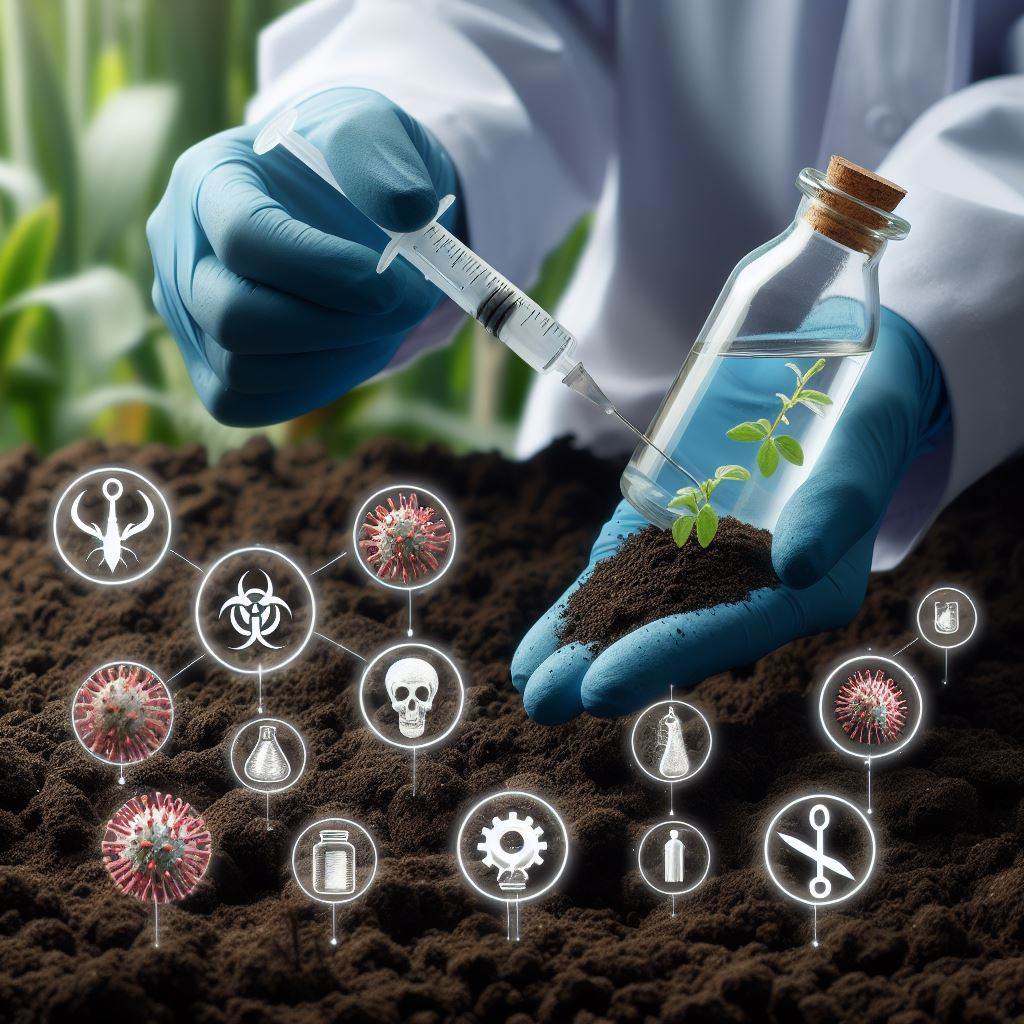Soil Care: Reducing Disease Risks
Last Updated on March 4, 2024
Introduction
Soil care is crucial in farming for maintaining healthy soil and ensuring successful crop growth.
This chapter focuses on the significance of reducing disease risks in farming through soil care.
Brief overview of the importance of soil care in farming
Soil plays a vital role in the success of farming. Proper soil care is necessary to maintain its health and fertility.
Healthy soil is the foundation for successful crop growth, as it provides essential nutrients and supports plant roots.
Moreover, healthy soil helps prevent soil erosion and conserves water.
Introduce the topic of reducing disease risks through soil care
Reducing disease risks in farming is a key aspect of soil care. Unhealthy soil can harbor various diseases that can affect crops and result in reduced yield and economic losses for farmers.
By practicing soil care techniques, farmers can minimize disease risks and promote a thriving farm ecosystem.
Soil care practices such as crop rotation, cover cropping, and organic amendments help break disease cycles and improve soil quality.
Crop rotation involves alternating different crops in a specific sequence, preventing the buildup of diseases that target specific plants.
Cover cropping involves growing specific plants in between main crops to enhance soil health and suppress disease-causing organisms.
Adding organic amendments like compost and manure to the soil enriches its organic matter content, which in turn promotes beneficial microbial activity.
These microbes aid in suppressing pathogens and improving overall soil health.
Moreover, maintaining proper soil moisture, avoiding over-fertilization, and practicing good sanitation measures contribute to reducing disease risks.
Soil care is crucial for successful farming, and reducing disease risks through proper soil management is essential.
By implementing soil care practices, farmers can maintain healthy soil, minimize disease risks, and ensure sustainable and profitable farming.
Understanding Soil-Borne Diseases
Soil-borne diseases and their impact on crop yields
Soil-borne diseases are caused by pathogens that live in the soil, infecting plant roots and reducing crop yields.
These diseases can have devastating effects on agriculture, leading to significant economic losses.
Soil-borne pathogens can either be fungi, bacteria, viruses, or nematodes. They are commonly found in the soil and can survive for extended periods, making them a persistent threat to crops.
When plants are grown in soil contaminated with these pathogens, they can become infected and develop diseases.
The impact of soil-borne diseases on crop yields varies depending on the severity of the infection and the susceptibility of the crop.
In some cases, diseases can cause total crop failure, leading to significant economic losses for farmers.
Even in less severe cases, infected plants may show reduced growth, lower yields, or produce poor-quality produce.
Examples of common soil-borne diseases and their symptoms
There are numerous soil-borne diseases that can affect crops worldwide. Some of the most common examples include:
- Fusarium wilt: This fungal disease affects a wide range of crops, including tomatoes, bananas, and melons. Infected plants show wilting, yellowing leaves, and vascular discoloration.
- Pythium root rot: Pythium is a water mold that causes root rot in many plants, including cucumbers, peppers, and lettuce. Infected plants exhibit stunted growth, root decay, and poor nutrient uptake.
- Bacterial canker: This disease affects fruit trees such as tomatoes, peppers, and stone fruits. It causes the formation of cankers on stems, leaves, and fruits, leading to reduced productivity.
- Nematode infestation: Nematodes are microscopic worms that can cause significant damage to plant roots. They puncture the root cells, impairing water and nutrient uptake. Affected plants may exhibit stunted growth, yellowing, and wilting.
How soil conditions contribute to disease development
Soil conditions play a crucial role in the development and spread of soil-borne diseases. Certain factors can create an environment favorable for pathogens, increasing the risk of disease outbreaks:
- Poor drainage: Excess moisture in the soil creates a conducive environment for pathogen growth. Waterlogged soil can lead to root rot and other diseases.
- Imbalanced pH levels: Extreme pH levels, either too acidic or alkaline, can stress plants and make them more susceptible to diseases. Some pathogens thrive in specific pH conditions.
- Nutrient deficiencies: Lack of essential nutrients weakens plants’ defense mechanisms, making them more vulnerable to pathogen attacks. Balanced nutrition is crucial for disease prevention.
- Crop rotation: Repeatedly growing the same crop in the same soil can lead to a buildup of soil-borne pathogens. Rotating crops helps interrupt the pathogen life cycle and reduces disease risk.
- Soil sterilization: Certain soil treatments, such as steam sterilization or fumigation, can be used to kill pathogens present in the soil. This practice is particularly useful in greenhouse settings.
Understanding the nature of soil-borne diseases and their relationship with soil conditions is crucial for effective disease management.
Implementing preventive measures, such as crop rotation, proper drainage, and balanced nutrition, can significantly reduce disease risks and ensure healthy crop yields.
Read: Effective Soil Fertility Tactics Explored
Identifying Disease-Prone Soils
Factors that make soils more susceptible to diseases
- Poor drainage and waterlogged conditions promote the growth of disease-causing pathogens.
- Soils with low organic matter content are more susceptible to diseases.
- Compacted soils restrict air circulation and increase disease risks.
- Imbalanced soil pH levels can favor the development of certain pathogens.
- Intensive monocropping without crop rotation increases disease prevalence.
Methods for assessing soil health and identifying disease-prone areas
- Visual inspection: Look for signs of wilting, stunting, discoloration, or other disease symptoms in plants.
- Soil mapping: Collect soil samples from different areas of the field to create a detailed soil map.
- Molecular diagnostics: Use advanced techniques like DNA sequencing to identify specific pathogens present in the soil.
- Monitoring soil temperature and moisture levels to assess disease-conducive conditions.
- Observing weed species composition can indicate soil health and potential disease risks.
Importance of regular soil testing and analysis for disease detection
Regular soil testing is crucial in identifying potential disease risks and ensuring proper soil care. By conducting routine tests, farmers and gardeners can:
- Maintain optimum nutrient levels and pH balance to promote healthier plants and suppress pathogens.
- Adjust irrigation and drainage practices to prevent waterlogging and create better soil conditions.
- Monitor changes in soil composition and take preventive measures against emerging diseases.
- Implement suitable crop rotation strategies to break disease cycles and diversify the soil microbiome.
- Make informed decisions regarding the use of disease-resistant crop varieties or chemical controls.
Soil testing also helps in developing site-specific management practices, reducing unnecessary pesticide applications, and optimizing fertilization.
It provides valuable data for implementing integrated pest management strategies and sustainable farming methods.
Understanding the factors that contribute to disease-prone soils is essential in maintaining soil health and preventing crop losses.
By assessing soil conditions, farmers and gardeners can identify potential disease risks, take appropriate measures to improve soil health, and implement effective disease management strategies.
Regular soil testing and analysis are key in this process, enabling informed decision-making and ensuring long-term productivity and sustainability in agriculture.
Read: Organic Matter: Boosting Soil Quality

Implementing Preventive Measures
Crop rotation and its role in reducing disease risks
Crop rotation is a crucial practice for reducing disease risks and maintaining soil health. Farmers can strategically rotate crops to interrupt the life cycle of pathogens.
By planting different crops in a specific sequence, diseases that rely on the continuous presence of a particular host plant can be effectively managed.
Crop rotation breaks the cycle by depriving pathogens of a consistent host, reducing their survival and population levels.
Utilizing cover crops to promote soil health and suppress pathogens
Another preventive measure is the use of cover crops, which offer multiple benefits in terms of soil health and disease suppression.
Cover crops, such as legumes and grasses, improve soil organic matter, enhance nutrient cycling, and provide a physical barrier against soil erosion.
Additionally, some cover crops have bio fumigation properties that release natural compounds, known as glucosinolates, which can suppress soil-borne pathogens.
Importance of proper irrigation and drainage to prevent disease development
Proper irrigation and drainage practices are essential in preventing disease development. Over-irrigation or waterlogged conditions can create a favorable environment for pathogen growth and survival.
It is crucial to provide adequate water for plant growth while ensuring efficient drainage to prevent soil saturation.
Maintaining appropriate moisture levels is key to reducing the risk of diseases caused by waterborne pathogens.
Use of organic amendments to enhance soil vitality and disease resistance
Organic amendments, such as compost and manure, play a significant role in enhancing soil vitality and disease resistance.
They provide essential nutrients, promote microbial activity, and improve soil structure.
Moreover, organic amendments also contain beneficial microorganisms that can help suppress pathogens through competition or the production of antimicrobial compounds.
High-quality organic amendments are valuable tools for building healthy and resilient soils.
Implementing these preventive measures requires careful planning, monitoring, and adaptation to specific crop and soil conditions.
Farmers should consider factors such as crop susceptibility to diseases, soil type, local climate, and pest and disease pressure.
An integrated approach that combines multiple preventive measures can significantly reduce disease risks and improve overall soil health.
Crop rotation and cover cropping can be integrated into farm management plans to address specific disease challenges.
By rotating crops and incorporating cover crops, farmers can disrupt pathogen lifecycles and enhance soil health simultaneously.
This integrated approach improves soil structure, promotes beneficial microbiota, and reduces the need for synthetic pesticides.
Proper irrigation and drainage practices are equally important.
Regularly monitoring soil moisture levels and adjusting irrigation schedules accordingly can prevent waterlogging or drought stress conditions, both of which contribute to disease development.
The use of organic amendments, such as compost or manure, can provide numerous benefits to soil health and disease resistance.
By creating a favorable environment for beneficial microbes, organic amendments suppress harmful pathogens and enhance plant resilience.
Implementing preventive measures is crucial for reducing disease risks in soil care.
Through strategic crop rotation, utilization of cover crops, proper irrigation and drainage, and the use of organic amendments, farmers can enhance soil vitality, suppress pathogens, and improve overall plant health.
By actively implementing these measures, farmers can create a resilient and disease-resistant soil ecosystem.
Learn More: Agroforestry: Combining Crops and Trees
Implementing Integrated Pest Management (IPM) Strategies
In order to effectively reduce disease risks and ensure proper soil care, implementing Integrated Pest Management (IPM) strategies is crucial.
IPM is a comprehensive approach that combines various techniques to manage pests and diseases while minimizing environmental impact and ensuring economic feasibility.
Integrated Pest Management,IPM and its benefits in disease management
IPM is a holistic method that focuses on long-term prevention and uses a combination of approaches to control pests and diseases, minimizing the reliance on chemical treatments.
It aims to maintain the ecological balance and preserve the soil’s health by integrating different pest management practices.
The benefits of IPM in disease management are numerous. Firstly, it reduces the reliance on pesticides, which can have negative impacts on soil health and beneficial organisms.
Instead, IPM promotes the use of cultural practices, biological controls, and targeted chemical treatments when necessary.
Integration of cultural practices, biological controls, and chemical treatments in IPM
Cultural practices play a crucial role in IPM strategies. These practices involve manipulating the soil environment to create conditions unfavorable for disease development.
Examples include crop rotation, proper irrigation, and adequate spacing between plants to reduce humidity and increase airflow.
Biological controls are another important component of IPM. This involves using beneficial organisms such as predatory insects, parasitic nematodes, or microorganisms to control pests and diseases.
These natural enemies can help regulate pest populations, reducing the need for chemical treatments.
While chemical treatments are not the primary approach in IPM, they are sometimes necessary. However, the key is to use these treatments judiciously and selectively, targeting only the pests or diseases present.
This helps minimize the impact on beneficial organisms and overall soil health.
Monitoring techniques to detect early signs of diseases
Regular monitoring is essential to detect early signs of diseases in order to implement effective control measures.
Monitoring techniques include visual inspection, disease severity assessments, and the use of diagnostic tools such as rapid test kits or DNA-based tests.
Early detection allows for timely action, minimizing the spread and severity of diseases. It is important to monitor not just the plants but also the overall soil health, as certain soil conditions can predispose plants to diseases.
Regular soil testing can provide valuable insights into nutrient deficiencies or imbalances that may contribute to disease development.
Timing and decision-making process for implementing control measures
Timing is critical when implementing control measures in IPM. It is important to take action before diseases become too severe or widespread.
The decision-making process involves considering factors such as the disease’s economic threshold, crop growth stage, and weather conditions.
Implementing control measures should be based on scientific research, local recommendations, and the specific conditions of the farm or garden.
It is important to consider the effectiveness, potential ecological impacts, and cost-effectiveness of different options before making decisions.
By implementing Integrated Pest Management strategies, farmers and gardeners can effectively reduce disease risks while ensuring sustainable soil care.
IPM combines various approaches, including cultural practices, biological controls, and targeted chemical treatments, to manage pests and diseases.
Regular monitoring and timely implementation of control measures are vital for successful disease management.
Read: Water Management in Soil Fertility
See Related Content: Eco-Friendly Pest Control in Crop Management
You Might Also Like: Tech in Pest Control: Efficient Crop Protection
Other Best Practices for Reducing Disease Risks
Maintaining good crop hygiene and practicing sanitation in the field
Regularly remove crop residues and weeds to prevent the buildup of potential disease sources.
Ensure proper disposal of infected plants and weeds to avoid the spread of diseases.
Clean and sanitize tools and equipment used in the field to minimize disease transmission.
Practice crop rotation to disrupt disease cycles and reduce the risk of soil-borne pathogens.
Importance of proper seed selection and quality in disease prevention
Select seeds from reputable sources that provide disease-resistant varieties for your specific region.
Opt for certified seeds that have undergone thorough testing to ensure high quality and disease-free status.
Avoid using seeds from infected plants or those showing signs of disease to prevent introducing pathogens into your soil.
Consider treating seeds with fungicides or hot water treatments to eliminate potential pathogens before planting.
Consideration of resistant crop varieties
Choose crop varieties that are bred to be resistant or tolerant to common diseases in your area.
Resistant varieties can significantly reduce the risk of disease outbreaks and minimize the need for chemical interventions.
Consult local agricultural extension services or seed suppliers to identify the most suitable resistant varieties for your region.
Regularly monitor resistant varieties for any signs of vulnerability to ensure their long-term effectiveness.
Adoption of precision agriculture techniques for targeted disease management
Utilize remote sensing technologies and mapping tools to identify disease hotspots and target control measures accordingly.
Implement site-specific applications of fertilizers, water, and pesticides to minimize their overall use while effectively controlling diseases.
Employ precision irrigation systems that deliver water directly to the plant’s root zone, reducing soil moisture and potential disease outbreaks.
Use data-driven decision-making tools and predictive models to optimize disease management strategies and reduce economic losses.
By incorporating these best practices into your soil care regimen, you can effectively reduce the risk of diseases in your crops.
Remember that prevention is key, and maintaining a healthy soil environment is crucial for long-term agricultural success.
Stay informed about the latest research and advancements in disease management to stay ahead of potential threats.
Implementing these practices will not only safeguard your crops but also promote sustainable farming practices and protect the environment.
Read: Managing Soil Salinity for Better Yield
Conclusion
In this blog section, we discussed key points regarding soil care and reducing disease risks.
It is crucial to emphasize the importance of regular soil care in order to mitigate disease risks in farming.
We strongly encourage farmers to prioritize soil health, as it contributes to sustainable and disease-resistant farming practices.


